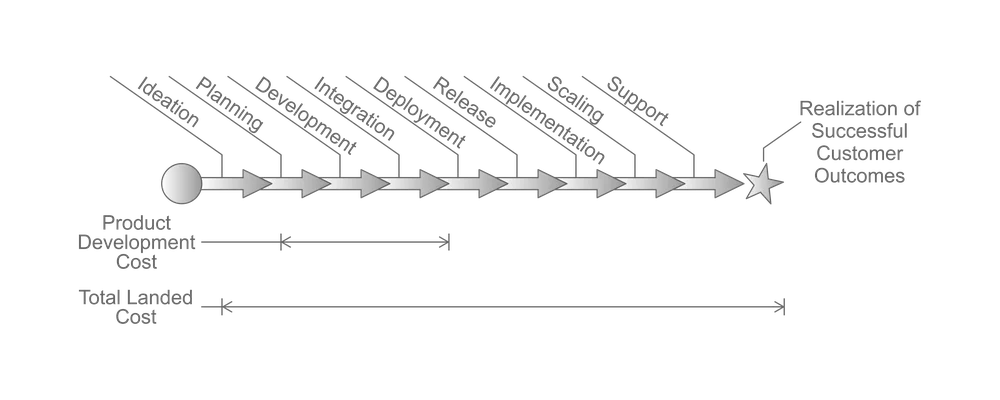How much do software supply chain decisions really cost?




Software is expensive to build. Clients like to keep costs down. You meet in the middle, and no party is particularly excited about the outcome. What if a more satisfactory result could be achieved for both parties?
Reengineering software supply chains to support successful end customer outcomes brings value to both parties. Rather than minimizing the direct cost of a software project (which leads to the aforementioned suboptimal outcome), we can instead optimize Total Landed Cost.
Supply chain decisions: What is Total Landed Cost?
When talking about supply chain decision-making, it’s often in the context of shipping and logistics companies, construction, or even healthcare: physical industries with physical products, transport routing, and utilizing third parties to achieve a goal.
Total Landed Cost is described within supply chains as the direct cost from the vendor and includes shipping, warehousing, cost per part or weight, customs, time, and other factors (Pumpe and Vallée, 2015). For instance, Acctivate, a Quickbooks inventory management software, calculates (adapted from Feller, 2008, p. 86):
Total Landed Cost = Shipping + Customs + Risk + Overhead
Software development professionals often take a limited view of software supply chain decisions due to the lack of physical products and physical movement. However, the “build vs. buy” direct cost should be just one part of the consideration.
Calculating software Total Landed Cost for decision-making
Decision-makers in software development should view successful customer outcomes rather than a product or service as the value provided by the organization. This holistic perspective naturally minimizes (or at least “right sizes”) the role of product development.
Value is:
- Customer-focused
- Time-dependent
- Highly contextual
Instead of focusing on the lowest product development cost, organizations should minimize Total Landed Cost - the total cost incurred to achieve successful customer outcomes.
 Total Landed Cost graph
Total Landed Cost graph
Total Landed Cost here has several vectors, distinctly different from those detailed in manufacturing:
- Customer success and support activities execution,
- Innovation acceleration,
- Feedback mechanisms,
- Interdependencies with software subscriptions and cloud vendors,
- Fostering customer and partner relationships, and
- Rapid adaptation to changing customer demand and business environment.
When organizations continually provide more value to the customer rather than “adding value to the product,” those direct cost calculations lose weight.
Pumpe and Vallée, (2015, p. 39) adapted a proposed IS Success Model from DeLone and McLean (2003) that might be useful to quantify a range of benefits.

In the past, outsourcing software development activities were common. This activity resulted in dramatic reductions to direct labor costs. However, outsourcing partnerships can be fraught with a range of not directly cost-related difficulties: disparate values, lack of trust, communication breakdowns, quality issues, etc. This trend has now reversed as organizations adopt a new definition of value and minimize Total Landed Costs.
Towards a new cost paradigm
By switching focus from optimized, lowest-cost software production, we hone the supply chain to minimize the Total Landed Cost for the end goal - successful customer outcomes. Happy clients, repeat business, recommendations, and company growth follow; the focus on optimizing systems for customer satisfaction as the value of a project begets higher business returns.
| Conventional Approach | New Approach |
|---|---|
| Narrow focus on direct costs and short term | Wider strategic and sustainable growth focus |
| “Build vs. buy” based on cost | “Build vs. buy” based on core competencies |
| Software supply chain provides products and services | Software supply chain as stakeholders with major design |
| Adversarial approach to software supply chain | Cooperative, partnership approach to software supply |
Next steps
Significant benefits can accrue from Total Landed Cost and Risk Analysis (Feller, 2008, p. 87):
- Providing a holistic view of sourcing costs and risks;
- Allowing a range of analyses to be completed;
- Performing “what-if’ analyses for use in supplier negotiation;
- Considering a wide variety of cost factors;
- Calculating a risk-adjusted cost using the supplier risk indices;
- Standardizing the cost analysis process, within the business, around one tool;
- Presenting support for sourcing decisions in low-cost countries, domestically or otherwise;
- Contributing to other business factors used in the decision-making process (e.g., supplier consolidation, global demand consolidation, and supplier partnerships);
- Archiving quote information for future use and reference;
- Organizing data entry and navigation to simplify model use;
- Including operational differences for global sites;
- Allowing for expansion and portability to other manufacturing businesses.
References:
DeLone, W. H. and McLean, E. R., (2003). The DeLone and McLean Model of information systems success: A ten-year update. Journal of Management Information Systems, 19(4), 9–30.
Feller, B. (2008). Development of a total landed cost and risk analysis model for global strategic sourcing (Doctoral dissertation, Massachusetts Institute of Technology).
Pumpe, A., & Vallée, F. (2015). The total landed cost concept. Begging for answers. In Operational Excellence in Logistics and Supply Chains: Optimization Methods, Data-driven Approaches and Security Insights. Proceedings of the Hamburg International Conference of Logistics (HICL), Vol. 22 (pp. 31-54). Berlin: epubli GmbH.


